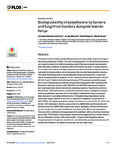Biodegradability of polyethylene by bacteria and fungi from Dandora dumpsite Nairobi-Kenya

View/
Date
2018Author
Muhonja, Christabel Ndahebwa
Makonde, Huxley
Magoma, Gabriel
Imbuga, Mabel
Metadata
Show full item recordAbstract
This study aimed at isolating and identifying bacteria and fungi with the capacity to degrade low density polyethylene (LDPE). The level of biodegradation of LDPE sheets with bacterial and fungal inoculums from different sampling points of Dandora dumpsite was evaluated under laboratory conditions. Incubation of the LDPE sheets was done for sixteen weeks at 37˚C and 28˚C for bacteria and fungi respectively in a shaker incubator. Isolation of effective candidates for biodegradation was done based on the recorded biodegradation outcomes. The extent of biodegradation on the polyethylene sheets was assessed by various techniques including weight loss analysis, Fourier Transform Infrared Spectroscopy (FTIR) and GC-MS. Fourier Transform Infra-Red spectroscopy (FTIR) analysis revealed the appearance of new functional groups attributed to hydrocarbon degradation after incubation with the bacteria and fungi. Analysis of the 16S rDNA and 18S rDNA sequences for bacteria and fungi respectively showed that bacteria belonging to genera Pseudomonas, Bacillus, Brevibacillus, Cellulosimicrobium, Lysinibacillus and fungi of genus Aspergillus were implicated as polyethylene degraders. An overall analysis confirmed that fungi are generally better degraders of polyethylene than bacteria. The highest fungal degradation activity was a mean weight reduction of 36.4±5.53% attributed to Aspergillus oryzae strain A5, 1 (MG779508). The highest degradation activity for bacteria was a mean of 35.72±4.01% and 20.28±2.30% attributed to Bacillus cereus strain A5,a (MG645264) and Brevibacillus borstelensis strain B2,2 (MG645267) respectively. Genus Aspergillus, Bacillus and Brevibacillus were confirmed to be good candidates for Low Density Poly Ethene bio-degradation. This was further confirmed by the appearance of the aldehyde, ether and carboxyl functional groups after FTIR analysis of the polythene sheets and the appearance of a ketone which is also an intermediary product in the culture media. To improve this degrading capacity through assessment of optimum conditions for microbial activity and enzyme production will enable these findings to be applied commercially and on a larger scale.
